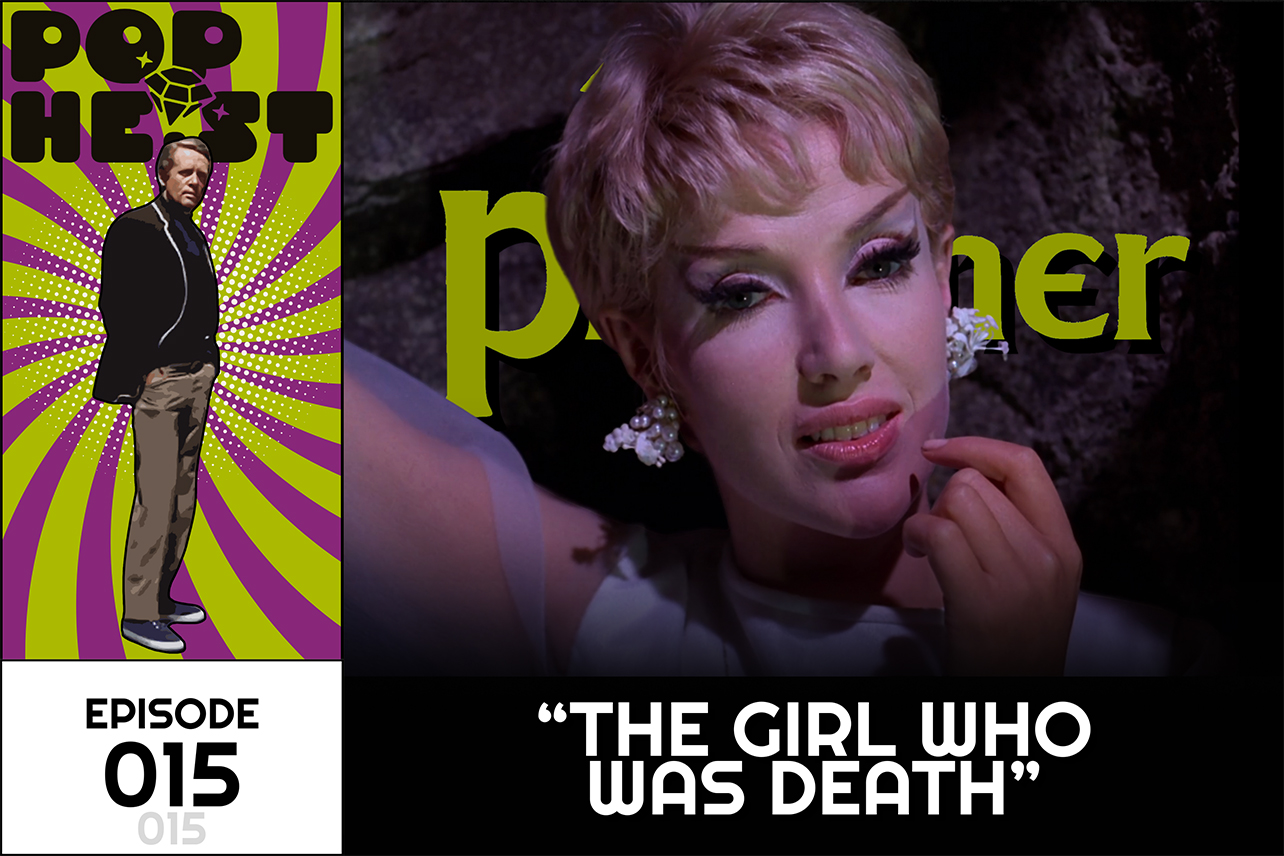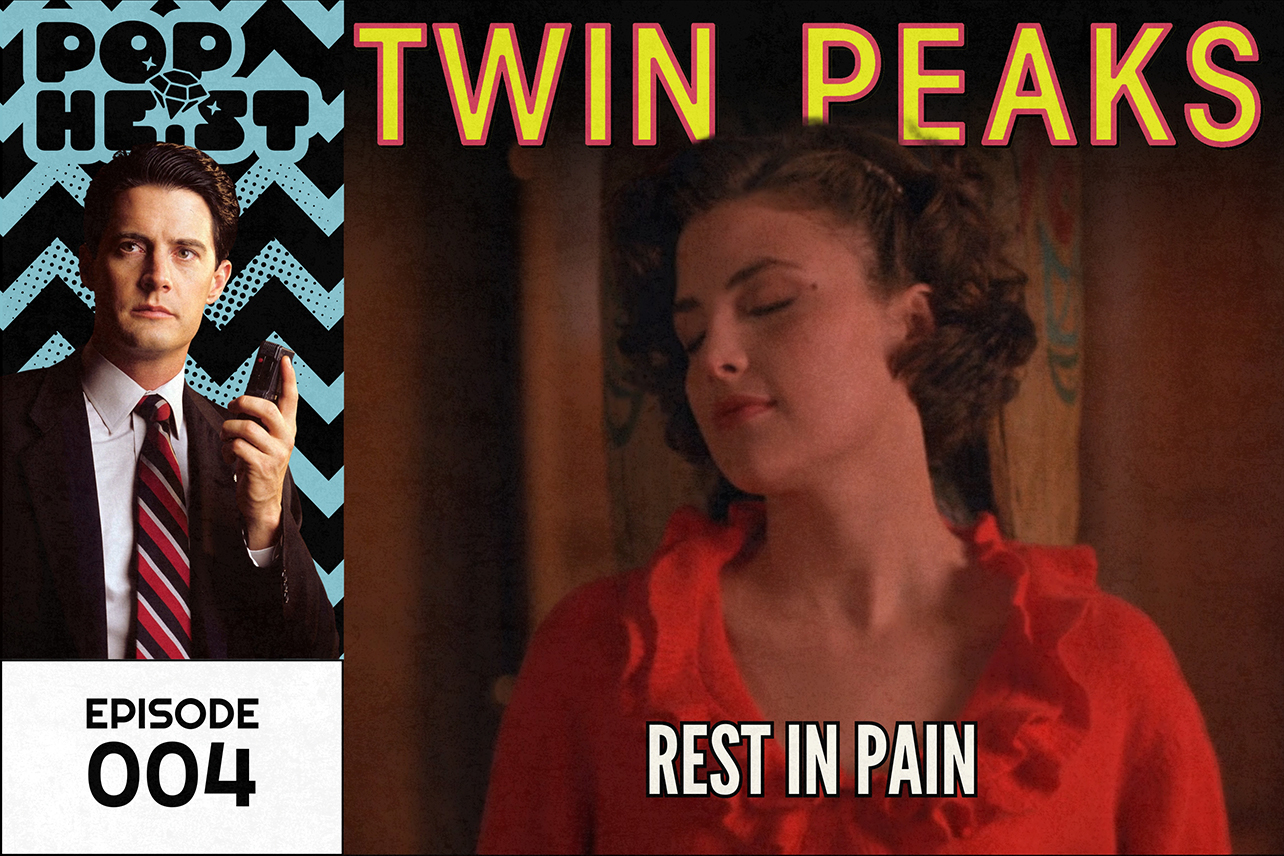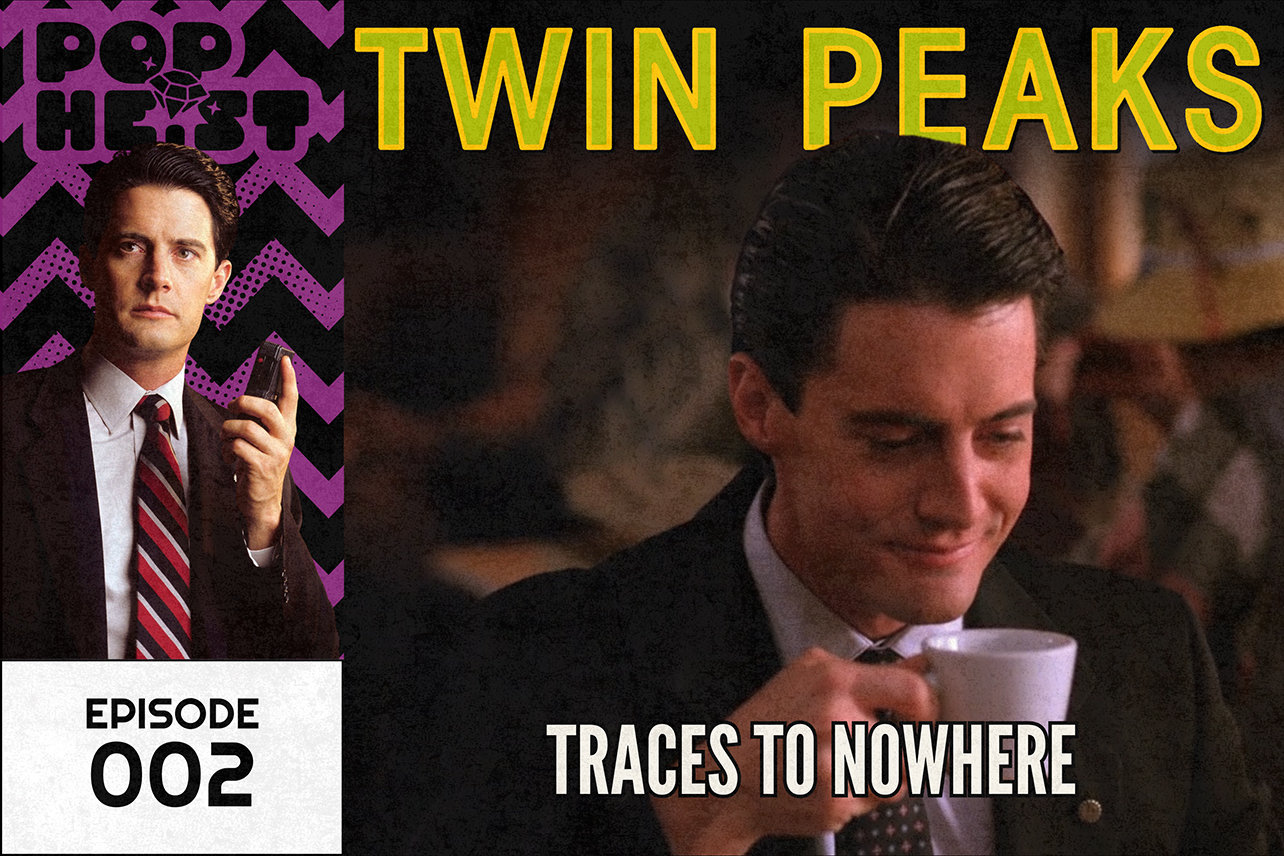In PRESTIGE PREHISTORY, Pop Heist critic Sean T. Collins takes a look at classic TV shows that paved the way for the New Golden Age of Television — challenging, self-contained series from writers and filmmakers determined to push the medium forward by telling stories their own way.
The Prisoner Episode 15 (airdate order) / Episode 15 (AVC order)*
"The Girl Who Was Death"
Original Airdate: Jan. 18, 1968
Writer: Terence Feely
Director: David Tomblin
Cast: Patrick McGoohan, Justine Lord, Kenneth Griffin, Christopher Benjamin, Alexis Kanner
*NOTE: The Prisoner's proper running order is a matter of dispute; Pop Heist is using the AV Club order for the show
Throughout The Prisoner, Patrick McGoohan and his collaborators have been restless to the point of mania. Any rule they can break in their story of a lone intelligence operative pitted against unknowable and implacable forces, they break, even if it was their own rule to begin with. Episodes with different opening credits. Episodes with no opening credits. Every episode is about escape, until they aren't. Every episode features Rover and the Announcer, until they don't. Every episode has a new Number Two, except the ones that reuse old ones. Episodes that begin with twenty minutes of silence. Episodes in which Number Six is a suave secret agent in Paris. Episodes set in the Old West.
Seen in that light, "The Girl Who Was Death" is perhaps The Prisoner's boldest experiments yet. It alone dares to ask the question: What if an episode of The Prisoner was really, really stupid?
Stupid like a fox, of course. Working from a script by Terence Feely, director David Tomblin, a pivotal player in The Prisoner's production, knows that this screwball Swinging '60s British super-spy pastiche is silly as hell.
But I've seen what a total failure to do this in an entertaining fashion looks like. A couple years ago I learned that the acclaimed, blackballed director Joseph Losey (The Servant) had made a movie adaptation of Modesty Blaise, Peter O'Donnell and Jim Holdaway's comic strip about a sexy British secret agent. The cast is nuts. Michelangelo Antonioni muse Monica Vitti (L'Avventura), who gets my vote for the most beautiful actress of all time, stars as Modesty. A devastatingly sexy young Terence Stamp (The Limey) plays her male gal Friday, Willie Garvin. Closeted matinee idol turned art-house legend Dirk Bogarde (The Night Porter) is cool as a cucumber as the bleached-blond supervillain, Gabriel. The theme music memorably was sampled by the old avant-garde hip-hop project Deltron 3030. There's a musical number at the end. With those ingredients, how could you go wrong? Why had no one recommended this to me before? Why is Modesty Blaise not an iconic work of Sixties pop culture?
Ha. Hahaha. Watch the movie to find out!
This is not that, though. Not at all. It's clear from the start of this episode that what we're watching is not to be taken literally, not even in the way of a traditional comedy like Modesty Blaise. Right at the beginning, and after each commercial break, the hands of an unseen figure turn the pages of a picture book, the bright painted images on the pages corresponding to different parts of the story. We know this is some kind of yarn or legend or fairy tale, not the truth, nor a funny facsimile thereof. Someone's telling a story, or being told one.
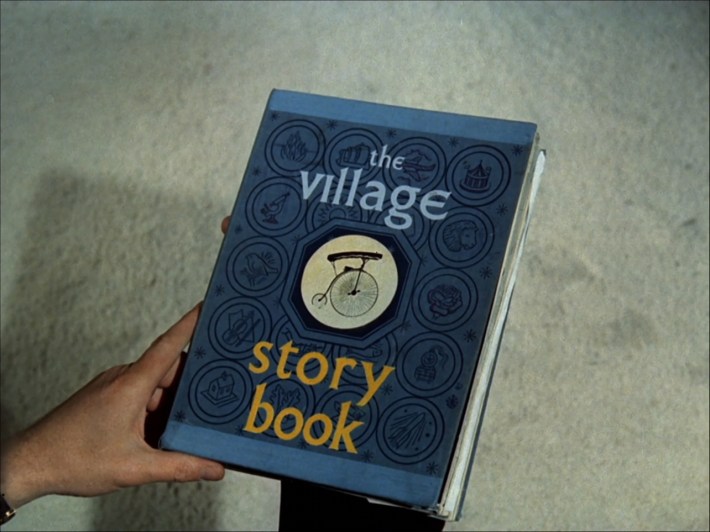
Indeed, we're not in the Village when the action begins. We're on a cricket pitch in Jolly Olde England, where a winking, mustachioed old agent, Colonel Hawke, (George McGrath), blows up after swinging at an explosive-rigged cricket ball. The field agent on hand — called Potter, he shares a name with a government agent from "Do Not Forsake Me Oh My Darling" and a face with a Number Two underling played by the same actor, Christopher Benjamin, in "The Chimes of Big Ben" — calls in none other than Number Six. Our hero's out and about and wearing a jaunty cap in England, so already we know this episode can't end before we solve the mystery of why, or even whether, he's not in the Village anymore.
For a while, it seems as though this may be a flashback to his pre-Village adventures. Since the Village itself is so far out, is it that hard to believe that Six's career involved wearing preposterous disguises — a cricketer, Sherlock Holmes in sunglasses for some reason — in pursuit of deadly, sexy quarry?
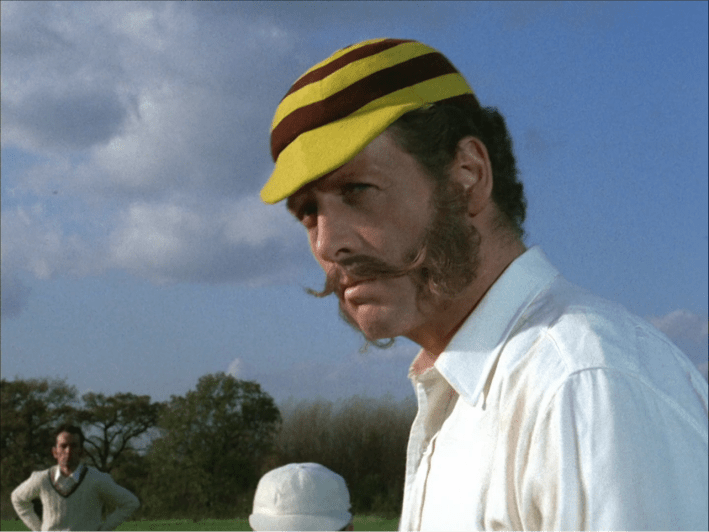
The quarry in question is the episode's eponymous female assassin (Justine Lord, who made quite an impression on me, boy howdy). A knockout blonde with modish makeup and an Emma Frost–level fixation on high fashion in white, she's the killer daughter of a mad scientist named Schnipps (Kenneth Griffith), who's been building a giant rocket with which to flatten London for the past few decades. Six's goal is to track him down and stop him without the Girl killing him first.
What follows is as over-the-top as a 1966 Batman episode, right down to Schnipps's delusional belief that he's Napoleon Bonaparte, with the secret lair, the outfit, and the costumed henchmen to match. The Girl leaves him a series of clues to keep him on her trail, attempting to bump him off all the while. When she poisons his drink, he drinks himself sick to puke the poison back out.
She leads him to an amusement park, where she enlists him in a boxing match, taunts him in the Tunnel of Love, rides a roller coaster with him, and keeps getting away when he mistakes her for the similarly dressed subject of some hipster photographer's latest shoot. (The photographer is played by an uncredited Alexis Kanner, aka The Kid from "Living in Harmony." As with Potter, make of that what you will.)
Fleeing in a white car with a matching white helmet that might as well belong to Speed Racer, the Girl draws Six into an old abandoned village, in which each building is rigged with genre-standard booby traps: motion-activated machine guns, trapped doors leading to electrified spikes, cyanide-fume candles that explode when they go out. Our resourceful hero, who needless to say goes unnamed in this adventure, makes it out alive, and uses a bulldozer to block the incoming fire from the valkyrie-like Girl's tripod-mounted gun emplacement. (It's that kind of episode.)
Using the cover of an explosion to play dead, he tracks the Girl back to her father's lair, a lighthouse that's secretly the long-brewing super-rocket. Six makes short work of the supervillain's goons — hilariously, they're all Scottish or Irish or Welsh or Northern and have basically been promised vengeance against London in exchange for their services — and traps them in their own weapon, which explodes on the launchpad…
…and then Number Six closes The Village Story Book and finishes telling "the story of how I saved London from the mad scientist" to a handful of adorable little kids. (And their unbelievably prominent and regrettable racist-caricature "golliwog" plush toy, a longtime English favorite.) He stares right into the unseen surveillance camera as he departs.
Back in the control room, we see whom he's staring at. We meet this episode's Number Two, concealed during the opening credits, and his assistant, Number 11; unsurprisingly, they're the basis of Schnipps and his deadly daughter. There was no big sci-fi scheme afoot this time, no elaborate ruse to break the prisoner's spirit: They were just hoping he'd open up around children, that's all. Instead, in classic Number Six fashion, he decided to have a little fun at a Number Two's expense. Honestly, sir, what did you expect?
It needs to be said right up front that this is a very, very silly episode of any television show, let alone The Prisoner. It's drawing from the already pretty ridiculous post-Bond Sixties spy genre in movies and television, the same source material for Modesty Blaise and, decades later, Austin Powers. Director David Tomblin was McGoohan's collaborator on his own contribution to that genre, Danger Man. This is two old hands having some fun at their own expense, and on their own expense for that matter. It's their production company!
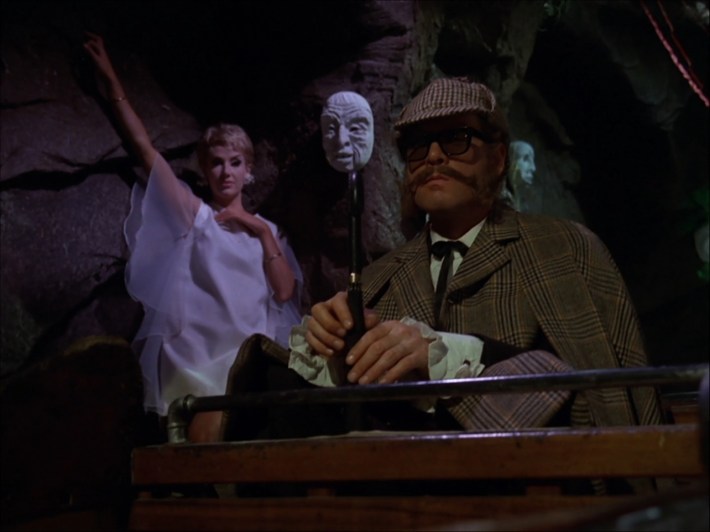
If you've come to love Number Six as the quick-witted, sneakily cheeky, but ultimately ramrod-stiff icon of independent thought he is in the Village, there's a distinct possibility the version of Six we meet in this episode will be … how should I put this … unbelievably annoying. He wears ridiculous disguises that feel beneath the man's dignity. His escape attempts are unnecessarily belabored: he struggles to block a rising spike floor with a box lid one-handed instead of simply pulling himself up to safety, he fiddles fruitlessly with a rope tying him to a chair that he can clearly untie by hand, etc. He deploys puns that would embarrass Freddy Krueger.
Simply in terms of plot urgency, moreover, it's clear so early that we're watching something imaginary even within the world of The Prisoner that it's hard to get invested. This isn't "Living in Harmony", which goes harder than any episode so far other than "Many Happy Returns"; this is more like the Roseanne where the Conners are the cast of Gilligan's Island for some reason. Even the Girl's outlandish traps lack the Village's customary verve for the bizarre and surreal.
Batman genuinely does seem like an influence as well, though I'm neutral on whether that's good or bad. There's really no way for an American audience member familiar with that show to look at the mad Doctor Napoleon and his minions and not see King Tut or the Penguin. A creepy clown figures heavily in the iconography of the amusement park to which the Girl invites Six; at the end of the episode, when he wants to send the observing Number Two a final eff-you, he sticks a toy clown right in the camera's view, clearly communicating what he thinks of this villain of the week.
Yet this episode also features some of the show's most vivacious, experimental filmmaking yet. A series of quick cuts during the cricket matches bring us several steps closer to the batter in a series of disorienting leaps; the bowler runs toward the camera at high speed, his face looming distortedly large in the lens. The editing during the amusement-park chase featuring Six, the Girl, the photographer, and his subjects is rapid to the point of borderline incoherence. That whole sequence feels like a tip of the cap, or a thumb of the nose, to Antonioni's sexy-London-photographer thriller Blow-Up, an arthouse classic starring David Hemmings and Vanessa Redgrave.
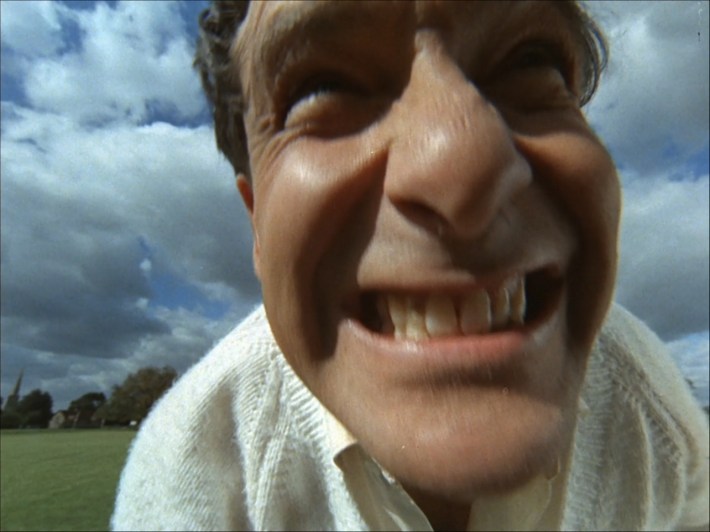
And the villains! Kenneth Griffith is a hoot as Schnipps/Napoleon/Number Two, with his delusions of grandeur, dyspeptic personality, and a comb-forward that seems plastered to his scalp by flop sweat alone. And Justine Lord is … how should I put this … crazy hot as the Girl. She looks fantastic in white, her makeup is killer diller, there are enough shots of her legs that they should be billed separately in the credits, and the look she shoots Six with her finger in the mouth as he passes by in the Tunnel of Love could boil the water under his boat.
It's the most laugh-out-loud funny episode of the series, that's for sure, though your comedy mileage may vary. When the soon-to-be assassinated Col. Hawke winks at Potter through the spy's binoculars, or when Six gets out of the steam bath the Girl traps him in (complete with bubble helmet) dressed in full Sherlock Holmes cosplay, I roared. Number Six uses a machine gun, for crying out loud!
This show never stops showing you things you didn't expect to see.
That extends to this whole episode. It's an inessential installment, out of step with the tone, style, moral gravitas, and kaleidoscopic dystopianism of the rest of the series. It's a lark. But as such, it's an exception that proves countless rules, showing you why The Prisoner usually works so well by doing basically everything it doesn't do. It's here for your amusement (and McGoohan and Tomblin's, one presumes), and is that a crime? Even the Village has a marching band.
This recap was originally accessible to paid subscribers only, and future recaps in this series are available now for paid subscribers. If you haven't already, consider supporting worker-owned media by subscribing to Pop Heist. We are ad-free and operating outside the algorithm, so all dollars go directly to paying the staff members and writers who make articles like this one possible.
